Driving/Navigating in Japan:
Are you ready for a fun, stimulating and memorable driving experience in Japan?
Then driving outside the large cities is just your ticket (no pun intended). There is no point for international visitors (i.e., "tourists") to drive a car (or motorcycle) in the large cities as they will find it to be very confusing (signage), slow (traffic) and expensive (parking and tolls). But out in the country-side things are much simpler, with less confusing options, slower speeds, much nicer scenery, and countless memorable sights and experiences.
Note that local Japanese drivers and expatriates (non-Japanese working in Japan or in East Asia who come to visit) can also take advantage of the benefits of driving outside the large cities.
Who should drive in Japan?
If this is your first visit to Japan, you probably should stick with taking the excellent high-speed trains that connect all the major tourist cities. Depending on how much actual traveling around you will be doing, and how long you will be staying you may find that a Japan Rail Pass, good for 7, 14 or 21 continuous days may be your best option. Once you have seen all the "must see" cities and sites you can then take a more leisurely pace on your next visit. We are confident that you will not be satisfied with only one visit to Japan. Tourism statistics show that 60% of the international visitors to Japan are there on their 2nd or more visit!
Can you drive a car or motorcycle in Japan?
If you don't have a Japanese driver's license, which most international visitors won't, you must have an International Driving Permit (an "IDP"; there are a few specific country exceptions to this rule), in addition to your home country's driver's license.
VERY IMPORTANT: If you don't have both a valid IDP and a valid, appropriate home country driver's license you will not be allowed to rent a car or motorcycle in Japan.
Should you drive a car or ride a motorcycle in Japan?
Keeping in mind that driving anywhere is a serious activity, if you are a good, capable driver/rider at home, you should have no problem in Japan. The main difference, for most visitors, is driving on the left (opposite) side of the road with the steering wheel on the right side of the car. In our experience one can adjust to this change fairly quickly (see interesting left-right history article). We do recommend, however, that if renting a car you only rent a car with automatic transmission so you don't have to worry about mastering a left-handed stick shift. Motorcycles in Japan operate the same as in the rest of the world.
Where should you start your drive in Japan?
Most international visitors will arrive in Japan via Tokyo (Narita or Haneda airports), or Osaka (Kansai airport). The farther you will be going from Tokyo, e.g. Hokkaido, Kyushu, or Okinawa, the more likely you will need to fly. For most other destinations, particularly on Honshu the main island, or Shikoku you will be better off traveling by Japan Rail (JR) Shinkansen (bullet train). Bullet trains are the fastest, most convenient way to cover large distances in the shortest time, and when traveling, "time is money." We currently don't have any itineraries or recommend driving from Tokyo or Osaka. It is just not worth the time and trouble. It is much better to take a convenient train to a nearby city or town a lot closer to where you want to actually begin your drive/ride. Our itineraries are not meant to be long "drives" but rather enjoyable "day-trips" filled with a variety of interesting sites, scenery and experiences. Most of our itineraries, for convenience and as a point of reference, start at a train station in a smaller city or town. A variety of rental car company offices are usually located near these central train stations and vehicles can be reserved online.
After reviewing itineraries that are of interest to you because they are in the prefecture you will be visiting, or feature something of special interest to you, e.g. cherry blossoms, scenery, temples, museums, art, etc. you can select and save the itinerary or itineraries to your "account" which you can set up with just an email address and password. You will then be able to choose a more specific "start point" for your itinerary, e.g. a rental car/motorcycle office, or a hotel. Similarly you can and should customize your chosen itinerary with your "end point", whether a train station, a rental car/motorcycle office, or a hotel. (Keep in mind that normally you can rent a car one-way, dropping it off in a different location from where you picked it up. If this is in the same prefecture there is usually no charge. (Unfortunately at this point you will still have to return a rented motorcycle to the same shop where you rented it.) You will also be able to search for and add restaurants of interest, usually for lunch stops, and also to find suitable accommodations for the evening.
What makes driving a car/motorcycle in Japan so easy?
In line with Japan's enthusiasm for technology, and their complicated street and address system, they developed a unique coding system for the country called Denso MapCode. These MapCodes consist of up to 12 numbers, e.g. xxxx xxx xxx*x, that can identify a location to within about 3 square meters (about 9 feet). What www.drivejapan.info has done is identify the MapCode for the locations (tourist sites, accommodations, train stations, airports, restaurants, etc.) in each itinerary that you are most likely to want to visit. These MapCodes are included in all the itineraries on the website so when you pick an itinerary, whether you customize it or not, the list of stops all display their unique MapCodes.
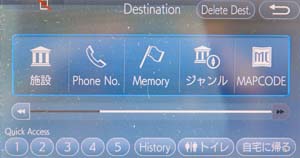
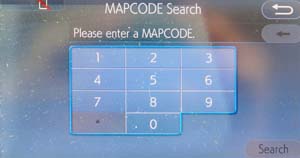
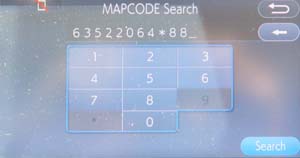
So, what do you do with these MapCodes?
All rental car, and most fairly recent domestic car navigation systems in Japan allow you to input a MapCode (or Japanese name, telephone number, etc.) for your destination and will then route you to that destination appropriately. Since you probably don't speak or read Japanese (see "Tips for Communicating in Japan" below for some help), using the MapCodes provided makes it "kids play" to follow an itinerary with the least hassles. Using a site's telephone number is also effective, assuming it is not a cell phone or located at the "head office", but only MapCode allows you to find sites such as scenic spots that don't have an address or phone number. And, if you end up still driving after dark (which we recommend you not to do), the MapCode for your accommodation will lead you inerrantly "home" safely for the night.
For motorcycle riders:
The situation is a little more complicated in that most motorcycles don't come with GPS navigation systems. We are currently trying to identify GPS navigation systems for rider's mobile phones that accept MapCodes. We should have a solution shortly. In the meantime motorcycle riders can set up their itinerary in various mapping apps, using the MapCodes for each stop as "way-points" along the way. These can be communicated to the rider's earpiece via Bluetooth or a cable.
International Driving Permit (IDP):
International Driving Permits (IDP) are issued to drivers in signatory countries to the Geneva Convention of 1949 (see a list of the countries here). Note that China and Mexico are not signatories and therefore cannot drive in Japan. The following 7 countries do not need an IDP but do need to have their driver's license officially translated (Belgium, Estonia, France, Germany, Monaco, Switzerland, Taiwan; check with their Embassy/Consulate).
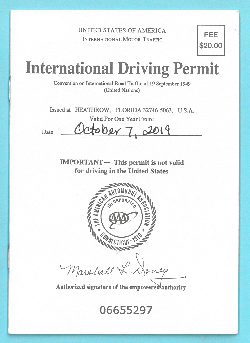
In the U.S., the American Automobile Association (AAA) can provide an IDP. Another provider in the U.S. is the American Automobile Touring Alliance (AATA).
In most countries a governmental organization usually issues IDPs, but it may delegate that authority to an automobile organization, as in the U.S. Please check with the local driver's license issuing authority in your country who should be able to direct you to the appropriate agency/organization.
With regards to renting a motorcycle, note that both your actual drivers license and your IDP must show that you are authorized to drive a motorcycle. The only exception is that a few motorcycle rental shops in the larger cities have "trikes", i.e., 3-wheeled motorcycles, for rent. Due to their stability they only require a regular car drivers license and IDP.
Rental Car/Motorcycle Companies in Japan:
There are five main Japanese rental car companies, listed below. There are a few other Japanese companies, but they are mostly resellers for these five main companies, or are small and localized. There are also several international brands in Japan, but again most of them are working through the main Japanese companies. Only a few have their own facilities and cars in Japan. Therefore, we would recommend that you work directly, via their international reservation websites, with one of these five.
You will note that several of the Japanese rental car companies are divisions of a car manufacturer, e.g. Toyota, Nissan and Times (formerly Mazda), meaning they will be promoting their car brand. This is not necessarily a problem unless you have a specific car brand in mind. If you are planning on only renting a car for a one-way drive, you should consider one of the larger companies as they will have the most locations around Japan where you can return the vehicle, not just at train stations and airports. (There are one-way drop-off charges in Japan, as in most countries, although if both locations are in the same prefecture this is usually not charged.)
You may be pleasantly surprised to see that Japan is very actively promoting hybrid and electric cars and that there are a large number of "quick" and "regular" electric charging stations throughout the country. They even appear on Google Map views with their own icon.
In selecting a rental car, we strongly recommend that you choose:
Japanese Rental Car Companies: (In order by number of outlets.)
Rules of the Road in Japan:
The Japan Automobile Federation (JAF), affilated with the American Automobile Association (AAA) in the U.S., as well as other national automobile associations, is an excellent source of information on driving in Japan. Please click on the button below to see an English version of the JAF "Rules of the Road" for Japan plus other related information. JAF Rules of the Road Please click on the button below to see various "Traffic Rules" for Japan from the Tokyo Metropolitan Police Department. Traffic Rules
Tips for Driving in Japan:
Avoid Expressways:
Please try to avoid driving on expressways if possible because there is usually very little to see and they usually charge significant tolls. The main reason to use an expressway is to get from one place to another as fast as possible as opposed to the local roads we recommend. For longer distances, however, we recommend taking local high-speed trains. For example, if visitors took the Shinkansen bullet train between Tokyo and Kyoto they would only need 2.25 to 2.5 hours and pay between US$124 and US$177 per person (even less if they have a Japan Rail Pass). In contrast, driving from Tokyo to Kyoto via expressway takes about 5.5 to 6 hours to cover the distance of about 450 km/280 mi, and paying tolls on the expressway of over US$200 one way, not to mention having to navigate safely in some of the largest cities in Japan!
Where to stop for Gas, Food, and Toilets:
Service Areas:
Japan has a number of "normal" and "unique" facilities for road travelers. All the major expressways/highways have "service areas" (other names: rest stops, oases, motorway service areas, lay-bys, etc.) that most international visitors would be used to. Other than areas purely for "resting/sleeping" these service areas normally include a gas/petrol station (some with natural gas supplies and many with electric charging stations as well, usually indicated on the signage leading up to the area), a well-stocked convenience store, one or more restaurants, and nice clean toilet facilities (all accessible).
Gas/Petrol Stations:
Gas/petrol stations are fairly common in towns, but you do need to keep an eye on your fuel gauge so you don't get caught short in a remote area. The good news is that most Japanese cars are so fuel efficient, and our itineraries are not usually long drives, so you will need a lot less gas. Note that some gas stations allow you to pump your own gas while others have attendants who do it for you. Given that most pumps only have directions in Japanese, you will be best advised to look for stations with attendants, if possible. Normally most rental cars take the least expensive grade of gas. Gas is sold by the liter, not the gallon (1 liter = 0.264 gallons; 1 gallon = 4.546 liters). Prices range from about JPY120/US$1.12 to JPY145/US$1.35 per litre. There should be no problem using a credit card to pay for the gas. Note that most gas stations do not provide electric charging stations. These are more commonly found in service areas, Michi-no-Ekis some shopping malls, and some accommodations now.
Michi-no-Eki:
On the "less traveled" roads we recommend in our itineraries you will find some wonderful alternatives to the expressway service areas. The best options are Michi-no-Eki. These are "roadside rest areas or stations," part of a nationwide network of over 1,100 outlets, whose obligation is to provide free 24-hour restrooms and parking, to promote regional foods and crafts, and to provide tourism information for the region. Most of these stations do not provide gas station services, but many do have electric charging stations. They all use the standard logo below.

Convenience Stores:
Another, even more ubiquitous option, is "convenience stores" (called "konbini" in Japanese). The 3 top chains in Japan have over 50,000 stores across Japan. The largest is 7-Eleven with about 40% of the market share and over 20,000 stores (vs. about 9,000 in the U.S.). Number 2 is FamilyMart with about 27% of the market share and over 17,000 stores. And third is Lawson with about 22% of the market share and over 14,000 stores. Unlike their Western models, convenience stores in Japan are clean, efficient operations with large inventories of a broad range of daily necessities, and fresh food items clearly labeled. Most are open 24/7 and have ample parking.



Vending Machines:
"Ubiquitous" is the best word to describe vending machines in Japan. They are everywhere there is electricity. You will be pleasantly surprised by the variety of offerings, including both hot and cold items. There are numerous coffee and tea choices, as well as juices, flavored waters, and even real water. Other machines offer snacks, ice cream, and cigarettes. It is estimated that there are over 5.5 million vending machines throughout Japan.
A fascinating history of vending machines in Japan can be found at "16 Things You Didn't Know About Vending Machines in Japan and Around the World"
Restaurants:
Although nowhere near as ubiquitous as vending machines, there are over 470,000 restaurants of all kinds in Japan. It is reported that Japan has the highest density of restaurants in the world with 1 restaurant for every 266 people vs. the second place U.S. with 1 restaurant for every 547 people. You will be pleasantly surprised with the variety of cuisines offered, not just Japanese food. The Japanese also emphasize freshness and quality so you are unlikely to have a bad meal. You can spend several hundred dollars (JPY10-20,000) on fancy meals, but there are plenty of restaurants offering meals for 10-15 dollars (JPY1,000-1,500). Most restaurants in Japan also have displays of the dishes they serve in a case or window by their door with prices so you can just point for what you want.
The only food problem you may encounter while driving is a scarcity of restaurants in more remote, rural areas. This is where stocking up at a convenience store or Michi-no-Eki before setting out for the day can be a good idea. You can search for "nearby convenience stores" on your phone's map app. (Note that the Japanese don't leave trash around. If you are picnicking you will have to take your garbage with you. It is a good idea to always have a bag in the car for garbage.)
Safe Driving Tips:
Here are a few "safe driving tips" for Japan. Note that Japan's rate of road fatalities per 100,000 inhabitants is 4.7 vs. the U.S. rate of 10.9 . The Japanese rate of road fatalities per 100,000 motor vehicles is 6.5 per vs. the U.S. rate of 12.9. It's rate of road fatalities per 1 billion vehicle kilometers is 6.4 vs. the U.S. rate of 7.3.
Tips for "Communicating" in Japan:
It is natural to worry about whether you will be able to communicate with "locals" in the "less traveled areas" of Japan. In fact anyone with a smartphone can download and install a voice translation app that eliminates this potential problem. With most of these apps you can speak into your phone in your native language, and then have it say the appropriate words in Japanese. The Japanese person you are talking to can then reply in Japanese to your phone and it will "talk" to you in your designated language. These apps aren't necessarily able to translate a long story, but if you keep each "transaction" to a sentence or two things should work smoothly.
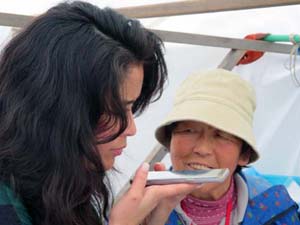
Links to Tourist Offices & Accommodations, etc.:
The following are useful links for tourism information in Japan:
Links to PREFECTURAL (equivalent to a State or a Province) tourism websites for specific information on each prefecture: